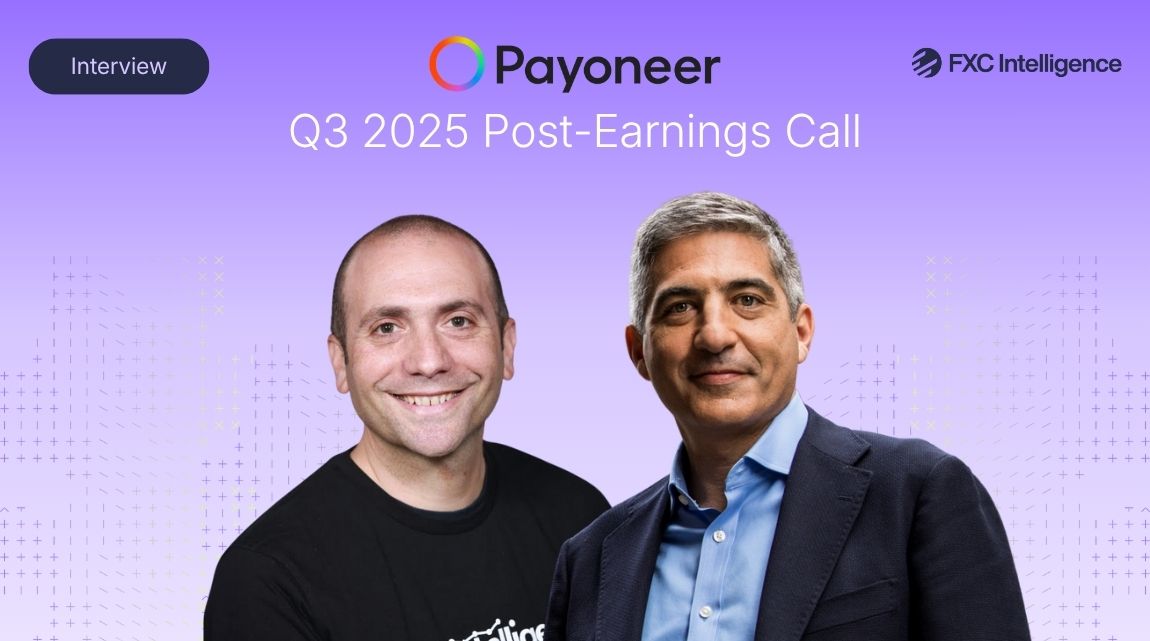Payoneer has reported strong Q2 2024 results, buoyed by strength across multiple segments and markets. As the company increasingly bolsters its emerging markets play, we discuss the drivers of its strong performance with CEO John Caplan.


Payoneer saw strong Q2 2024 results, reporting a 16% YoY increase in top-line revenue to $239.5m, while adjusted EBITDA grew 30% to $72.8m, providing an adjusted EBITDA margin of 30%.
The company also saw overall volume increase 22% to $18.7bn, as well as seeing growth in active ideal customer profiles (ICPs) – the metric Payoneer uses to identify its target customers.
Much of Payoneer’s customer base is in emerging markets and this continued to be critical to the company’s growth in Q2 2024, with many of these markets providing a higher take rate.
Payoneer also continues to focus on building a complete financial stack for cross-border small and medium-sized businesses (SMBs), particularly in emerging markets, which is allowing it to broaden the services it is providing to each customer. This translated into a 27% increase in average revenue per user (ARPU), and Payoneer also announced the acquisition of Singapore-based global payroll player Skuad to drive this approach further.
The strong results have not only pleased investors, but have also prompted the company to increase its FY 2024 projections for the second time.
To find out more about the company’s strong performance and emerging markets-led strategy, I caught up with CEO John Caplan, with additional insights from Michelle Wang, VP of Investor Relations at Payoneer.
Emerging markets and Payoneer’s geographic diversity
Daniel Webber:
Let’s start with your geographic diversity. Any business that serves emerging markets has to be mindful of this to avoid over-exposure to certain markets, which is a problem we’ve seen some players face, but your revenue mix by region is spread out. How are you avoiding being dependent on countries with high currency volatility?
John Caplan:
We have customers in 190 countries. We have ICPs effectively equally distributed across our global regions: a hundred thousand in Latin America, a hundred thousand in China, a hundred thousand APAC, a hundred thousand EMEA, a hundred thousand in Europe, etc.
We focused on tier one geographies where we think we have the exceptional product market fit, we have the regulatory framework we want and a real lead. And that’s working.
We are accelerating particularly in those services economies with the B2B offering really nicely. That is exceptionally good for us long term because those are also high-take rate geographies. Adding ICPs in China – our China franchise is doing very well, proud of the team there – but we’re a 70 bps or 60 bps business versus in Latin America where we’re multiples greater of that.
Michelle Wang:
What’s underappreciated or maybe misunderstood about Payoneer, given the geographic footprint, is our customers are actually doing business cross-border and so they’re really tapping into the strength of these countries exporting.
We also get the question a lot: ‘how is your business doing given we’re seeing macro data coming out of China saying the Chinese economy is struggling?’ But actually our customers are not exposed to what’s happening in the local Chinese economy or the local Indian economy because they’re focused on exporting their goods or services around the world.
Because of that, about 75% of our revenues are actually derived in dollars. The US is the largest importer of goods and services globally, and that’s the e-market that most of these emerging SMBs are selling into. The US is the biggest, but then you also see Western Europe, Australia, Canada, Japan. So with 75% of the revenues that we’re generating in dollars, our FX exposure and volatility is probably less than what people might think when they see Payoneer and the 190+ countries’ SMBs around the world.
Daniel Webber:
Nobody tracks imports, everybody tracks exports. Generally, you struggle to ever find a government that brings you good data on imports, but their export data is excellent.
John Caplan:
What’s really important is we’re on the right side of trade for the emerging market trade ministers of those countries.
When you look at the GDP of emerging markets, the fastest growing emerging markets and exports as a percentage of the growth of GDP and SMBs as a percentage of those exports, those things in Payoneer’s tier one countries align perfectly.
Payoneer sees growth across multiple emerging markets
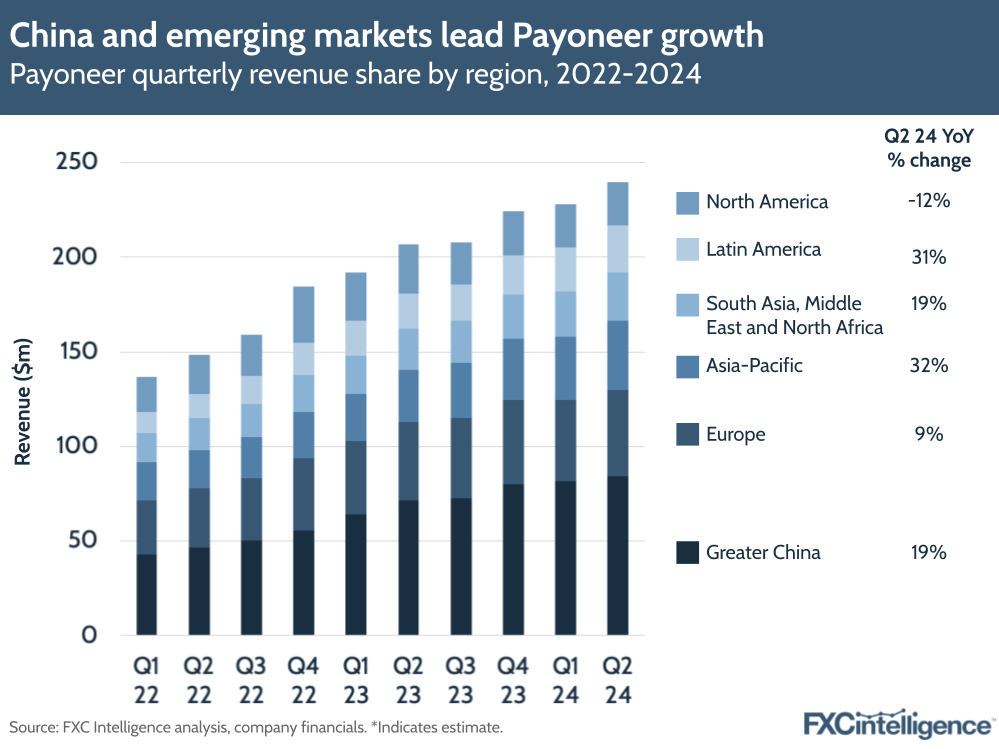
While Payoneer saw YoY revenue growth in every market it serves apart from North America in Q2 2024, some grew more strongly than others.
Greater China, which is the largest region in terms of revenue share at 35%, saw revenue increase by 19% YoY to $84.4m. It also now has the second-highest number of active ICPs, at 107,000, which grew 13% YoY in the quarter.
Asia-Pacific (APAC), however, has the largest number of active ICPs, at 130,000 and also saw the highest growth in this metric at 19%. This translated into the third largest amount of revenue, at $36.2m, but the fastest revenue growth (32% YoY). A highly emerging markets-focused region, APAC is one of Payoneer’s three higher take rate regions, alongside South Asia, Middle East and North Africa (SAMENA) and Latin America (LatAm).
These two also saw strong growth, with SAMENA seeing a 12% increase in active ICPs and a 19% increase in revenue, while LatAm saw ICPs increase 16% and revenue 31%.
Meanwhile, Europe saw its active ICPs reduce by -5% but its revenue climb 9%, while North America saw ICPs increase 7% but revenue drop by -12%.
Drivers of Payoneer’s top-line growth in Q2 2024
Daniel Webber:
Not only have you posted a really strong set of results, but the market is clearly recognising that too. Talk us through what drove such a strong quarter.
John Caplan:
We had strength top to bottom in our results, and the team executed really well across all of our KPIs.
The first highlight is the growth of our B2B franchise. We had 40% B2B volume growth in Q2, up from 33% in Q1 and up from 13% in Q4 of last year. The reason we’re seeing that growth is really a combination of a few things.
The first is an exceptional brand around the world: SMBs and emerging markets trust Payoneer. The next is that our go-to-market motion has been really focused on a set of tier one countries where we have people on the ground, where we have strong relationships with the ecosystem on the ground.
Then the third is we’re solving a problem that the emerging market SMB in B2B doesn’t have a good alternative solution to. We’re taking share from what are traditional local banks and we have better technology, better service level, exceptional pricing and speed.
Importantly, our larger SMBs have entities in multiple geographies around the globe. So they need a global multicurrency B2B account, which is what Payoneer offers. A business-grade B2B account that’s operable globally is something a local bank doesn’t actually provide. We’ve narrowed in on the multi-geography, cross-border SMB, which is a mouthful, but it actually is a massive segment of global trade.
Payoneer increases expectations for FY 2024
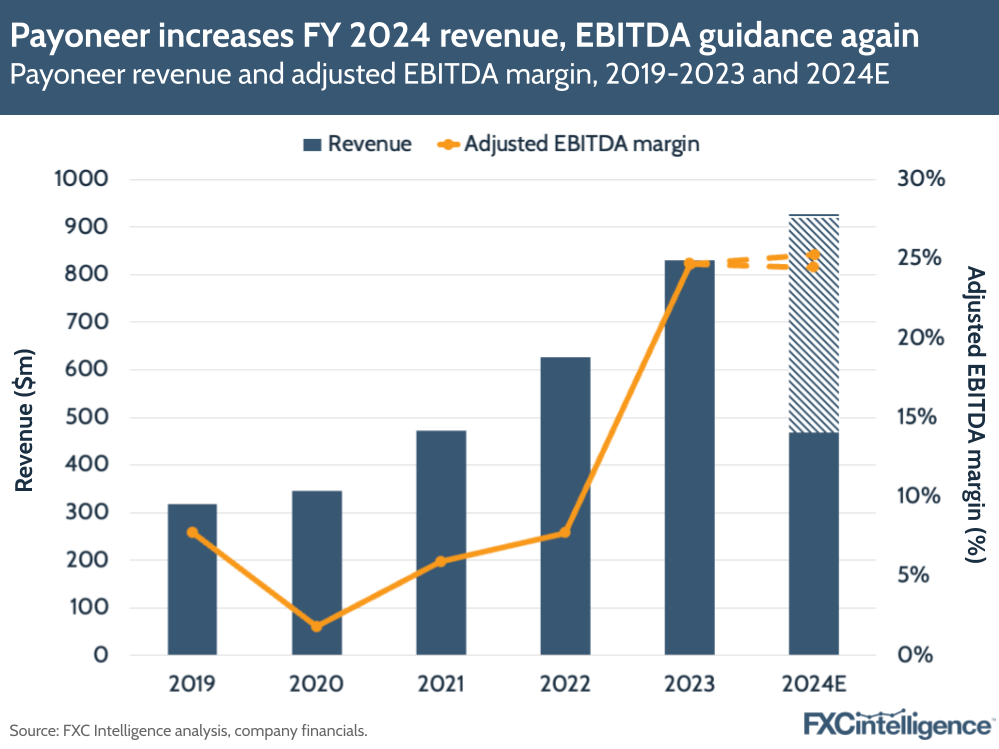
Although the company saw growth across its customer segments, other headwinds included ongoing growth in customer funds, which increased 9% YoY to $6bn at the end of Q2. This helped drive interest income, with the company reporting a 19% YoY increase to $66m, although Payoneer is projecting a more modest 4% YoY increase to $240m for FY 2024.
Without interest income, ARPU was still up by 18% in Q2 2024 and is seeing notable acceleration, having reported 13% YoY growth in Q1 2024, 9% in Q4 23 and 2% in Q3 23.
Against the backdrop of the strong results, Payoneer has increased its full-year guidance for the year for the second time. It is now projecting FY 2024 revenue of between $920m and $930m (a jump on its Q1 projection, itself a revision, of $895m-905m) and adjusted EBITDA of $225m-235m (up from Q1’s $200m-210m). This gives it a projected adjusted EBITDA margin of between 24.5% and 25.3% – either almost matching or slightly improving on 2023, its highest result to-date.
Building a healthy SMB B2B take rate
Daniel Webber:
Your SMB B2B take rate was 1.54% this quarter, which is a healthy take rate. It’s going to be below where the banks are, but it isn’t at 20 bps or similar – you can build a business off a take rate at that level.
John Caplan:
That’s a really important insight, because in the enterprise industry – and we have an enterprise pay-out business – those take rates are 30 bps. But if you look at a branded multicurrency business account where people are using a lot of our tools and services, we’re getting 150 bps.
As you said, you can build and scale a really big, profitable business in that way and, as it speaks to profit, you saw we’ve unlocked leverage through the first half of the year.
We’ve demonstrated that not only can we grow the revenue, acquire customers and retain them and provide a unique service, but we can run an increasingly healthy P&L as we provide more scale but don’t need to ramp expenses in line with our revenue growth or our volume growth.
Payoneer sees strong SMB performance
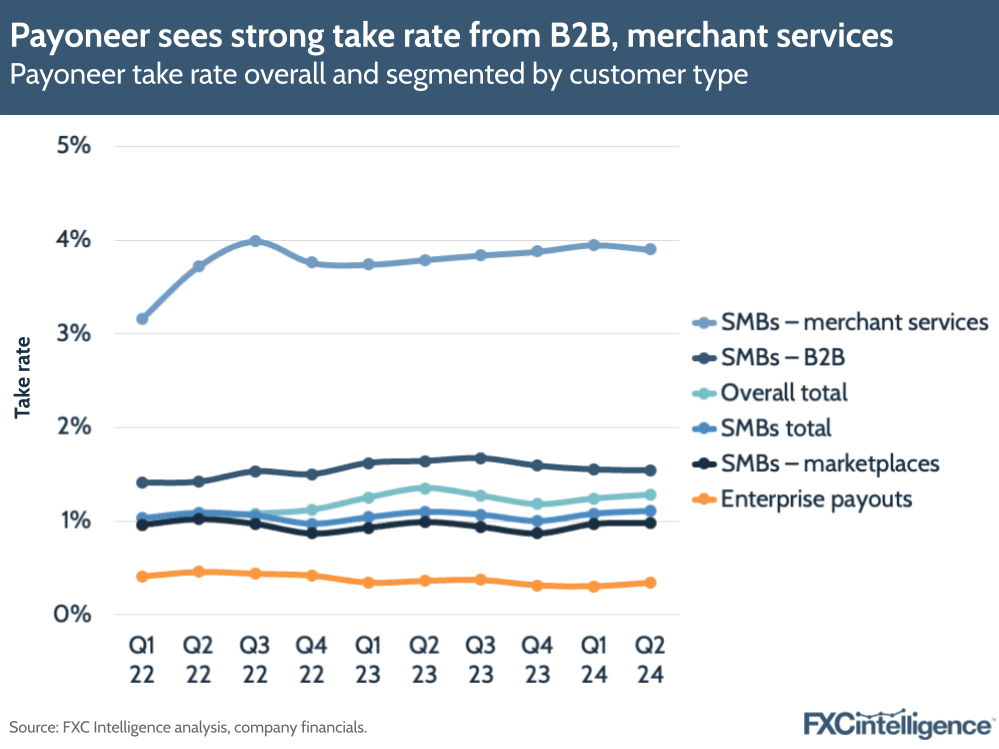
Payoneer saw strong performance from its SMB segments, with SMB overall seeing a 1 bps increase in take rate, a 19% increase in volume and a 21% increase in revenue.
With the second highest take rate at 1.54%, SMB B2B saw strong growth across revenue, increasing 32% YoY, and volume, where it grew 40% YoY. This is the second largest individual SMB segment in Payoneer’s offering in terms of revenue, accounting for 16% of the total, as well as 13% of the company’s volume, and so was a key growth driver for the company this quarter.
By contrast, the more recently established SMB merchant services (Checkout) segment, which accounts for less than 1% of the company’s volume and 2% of revenue, had the strongest take rate at 3.9%. It also saw the strongest revenue and volume growth, climbing 201% and 192% YoY respectively.
Meanwhile, marketplaces accounted for 61% of the company’s volume and 47% of revenue, growing at 14% YoY for revenue and 15% for volume, with a lower 0.98% take rate.
Payoneer’s enterprise business strategy
Daniel Webber:
Your enterprise business is the second-largest share of your volume, and is also growing strongly, but has very different customers to your B2B offering. Why is it important to have both customer types?
John Caplan:
We have relationships with marketplaces, some that are branded, where the volumes go into the SMB accounts. You see the marketplace line in our SMBs segment and we saw 15% growth there. That’s the strength of Amazon; the strength of Walmart; the strength of these big platforms, sending real volume and, in fact, beating their own guidance and us taking share in places like China and other places around the world. That’s on one side.
Then on the unbranded, direct-to-bank account, enterprise line, you see real growth there in the travel vertical, for example, which is about 50% of it. What’s interesting about travel is American consumers may be travelling less or planning to travel more narrowly, as we saw Airbnb report, but they also talked about travel to Asia and other parts of the world going way up and showing strength. And these are aligned really nicely with where Payoneer has lots of volume and lots of strength.
So having both the unbranded direct-to-bank business as well as the branded into the Payoneer account, we get the volume benefit obviously, which drives down costs overall for our operations; gives us visibility into the flows across the network; gives us stronger ways to have relationships with the biggest marketplaces in the world. It’s an important part of our franchise.
Performance in the enterprise business
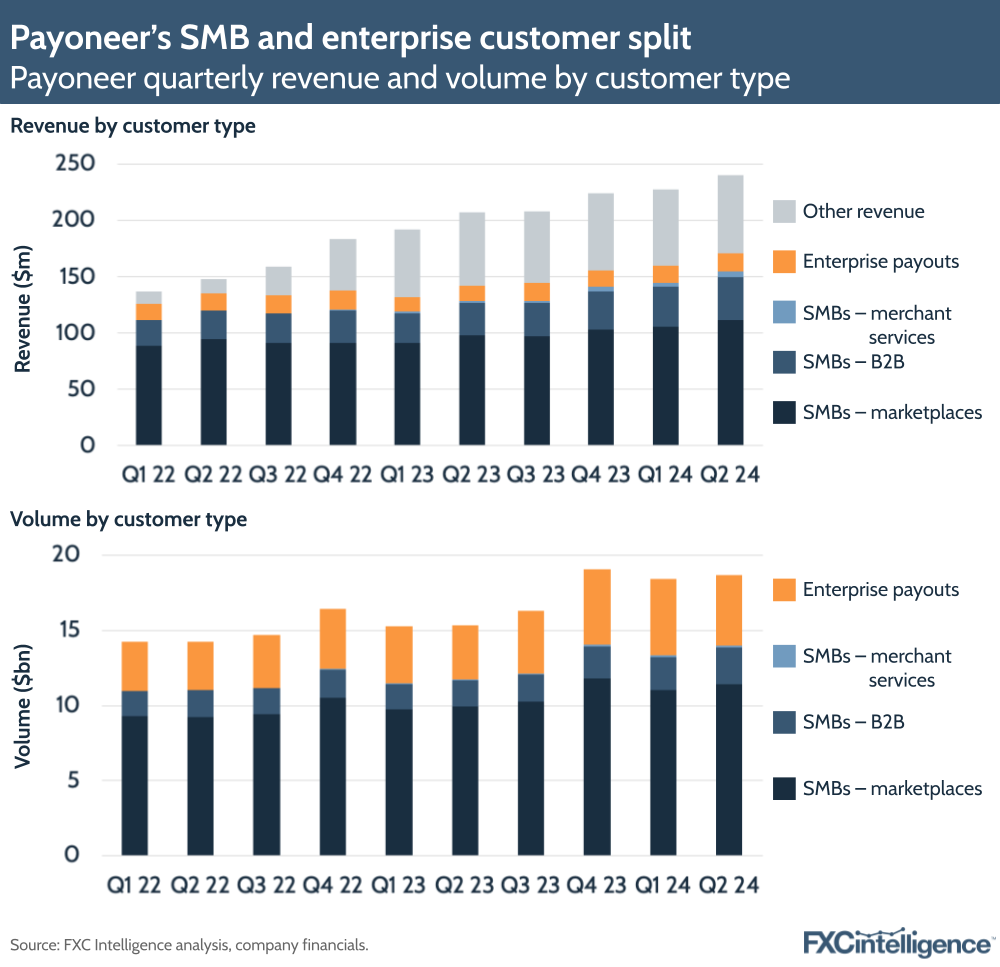
Accounting for 7% of revenue and 25% of volume, Payoneer’s enterprise payouts business has largely been buoyed by the travel vertical, where the company has expanded the number of markets it serves.
Revenue from this segment saw strong growth in Q2 2024, increasing 23% YoY to $16m. Meanwhile, enterprise payouts volume saw a 31% YoY increase to $4.7bn. However, the segment has the company’s lowest take rate, at 0.34%.
Growing Payoneer’s ideal customer profiles
Daniel Webber:
Let’s talk about your ICPs, which continue to grow. You’re clearly zooming in on who you really like as an ICP, as well as growing your incumbent ICPs. Talk us through how you are approaching ICPs.
John Caplan:
We saw north of 20% volume growth and north of 20% revenue growth from our largest ICPs. It was a very strong quarter in relation to the engagement of our high-value ICPs.
Our ICPs are business owners who are in high-growth emerging markets, who have business where their customers are in six or more geographies and their vendors are in six or more geographies. That’s a huge population of people and they have entities in multiple locations.
So cross-border SMBs with multi-geography entities need a multicurrency global business account for all their international AR and international AP. There are regional neobanks that provide real value, but they’re not multi-entity, there are local banks, which obviously have no technology on service, and I say that with respect.
Daniel Webber:
But it’s fair: the data shows that they can’t multi-region serve. They are unable to because they’re regulated entities and can’t do it, so it’s just the nature of what the market is.
John Caplan:
Correct, and this is the brilliance of the Payoneer organisation over 20 years. This was what Scott Galit and the founding team of Payoneer put in place: the licensing infrastructure; the bank relationship infrastructure; the brand and product platform globally to serve those multi-entity cross-border SMBs at scale.
We’ve identified that there’s 80 million of them. We have half a million, 550,000 ICPs. The real exciting thing for us is the market’s so big. In B2B, for example, we size the serviceable market at around $900bn, of which our volume is about run rate $10bn and grew 40% year-over-year.
We have a real long runway in front of us to capture more share and provide more products and services to those customers. We announced the acquisition of Skuad this week because those customers are asking us to help them manage their global contractors and global employees, because doing it on spreadsheets on Excel isn’t the right way to manage taking care of the payroll of the people who are building your product and service.
Driving growth in Payoneer’s ideal customer profiles
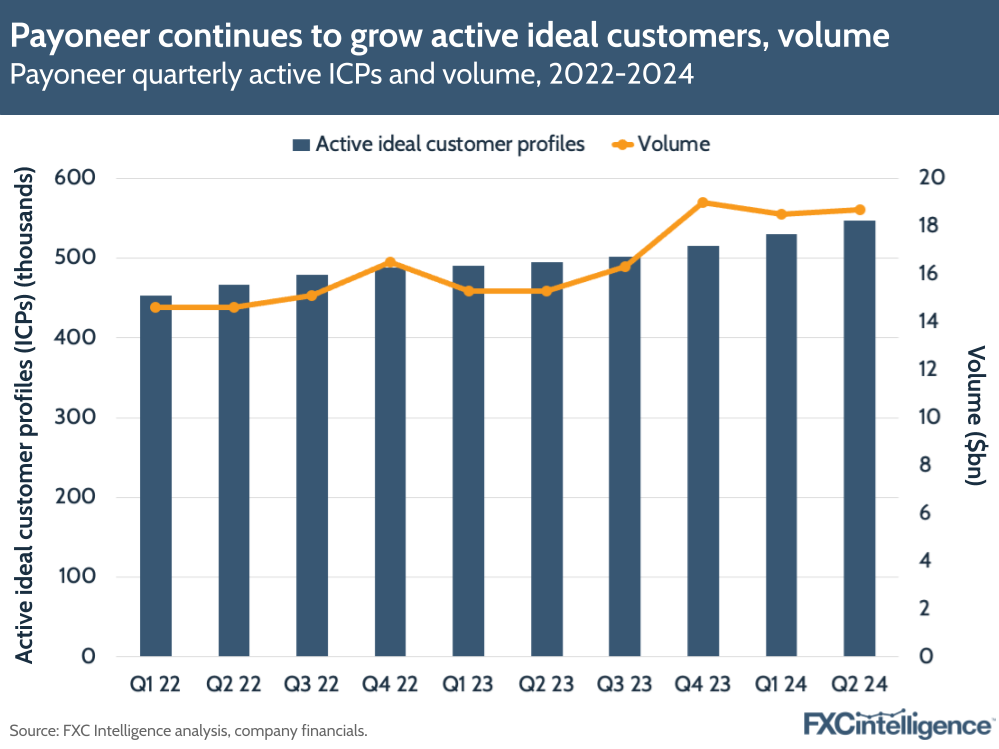
Overall, Payoneer’s active ICPs saw a 10% increase YoY in Q2 2024, to reach 547,000 in the quarter.
While this was aided by geographically growth, there was also a divide in growth across company size, with ICPs who average over $10,000 a month seeing 7% YoY growth to 55,000. This group also saw both volume and revenue growth by over 20% each.
Entering the global payroll market
Daniel Webber:
Where does your global payroll strategy fit in the market, versus players such as Deel, Remote, Papaya Global and Rippling?
John Caplan:
Those three companies are impressive companies and each of them have ex-Payoneer employees working for them, but each of them serve larger enterprises. Our wedge is the ICP and our ability to efficiently acquire those ICPs and cross-sell products to them.
What’s exceptional about the payroll arena is there’s room for all of these companies to flourish. Deel, Payoneer and Papaya Global will all flourish. We don’t need to take share from one another. We’re taking share from the Excel spreadsheets on people’s laptops.
We love those companies. We think they’re exceptionally strong and provide real service. And in many parts of the globe, those firms you mentioned use Payoneer’s rails to move money around the world. So we find we’re very complimentary businesses and we look to collaborate with them more.
25% of our B2B SMBs want to buy it from us, so we’re excited about cross-selling to them.
Daniel Webber:
John, Michelle, thank you.
John Caplan and Michelle Wang:
Thank you.
The information provided in this report is for informational purposes only, and does not constitute an offer or solicitation to sell shares or securities. None of the information presented is intended to form the basis for any investment decision, and no specific recommendations are intended. Accordingly, this work and its contents do not constitute investment advice or counsel or solicitation for investment in any security. This report and its contents should not form the basis of, or be relied on in any connection with, any contract or commitment whatsoever. FXC Group Inc. and subsidiaries including FXC Intelligence Ltd expressly disclaims any and all responsibility for any direct or consequential loss or damage of any kind whatsoever arising directly or indirectly from: (i) reliance on any information contained in this report, (ii) any error, omission or inaccuracy in any such information or (iii) any action resulting there from. This report and the data included in this report may not be used for any commercial purpose, used for comparisons by any business in the money transfer or payments space or distributed or sold to any other third parties without the expressed written permission or license granted directly by FXC Intelligence Ltd.

